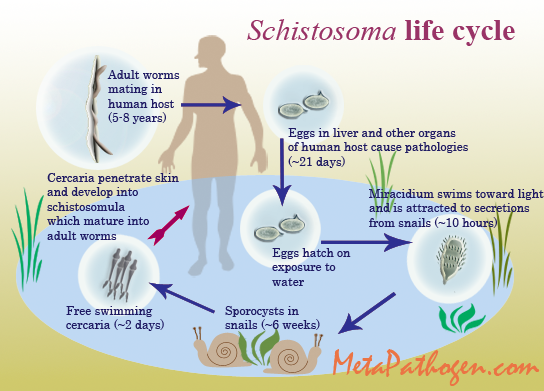Dirofilaria immitis, heartworm
Dirofilaria immitis is a filarial parasitic nematode that infects primarily dogs and other canid species. It usually resides in the pulmonary, femoral, and hepatic arteries, as well as other blood vessels including veins and right atrium of live dogs. Heartworms cause serious vascular damages and can be fatal, especially in working dogs with high level of physical activity.
The common name heartworm is originated from the fact that the worms are frequently found in the heart. However, it is considered to be a postmortem artifact. Heartworm is a vascular pathogen rather than an intracardiac one.
The vectors of Dirofilaria immitis larvae are many mosquito species. The following is an incomplete list of mosquito species that were shown to be capable of supporting larval development of Dirofilaria immitis to the 3rd (infective) larval stage: Culex pipiens (often infects cats), Anopheles maculipennis, Coquillettidia richiardii, Aedes triseriatus, Ochlerotatus notoscriptus (prevalent in Australia), Aedes albopictus, Aedes aegypti, Culex quinquefasciatus, Aedes taeniorhynchus, Aedes scapularis, Aedes trivittatus.
Dirofilaria immitis is capable of infecting wide variety of mammals (cats, dogs, rodents, horses, humans), as well as birds (there is a documented case of the parasite infecting the Humboldt penguin). Human pulmonary dirofilariasis, while being a benign and relatively rare zoonosis, represents itself as a medical problem, because it being manifested as a "coin lesion" similar to pulmonary neoplasia (tumor) that warrants unnecessary invasive diagnostics and even surgery.
Frequency of infection in organisms other than dogs often depends on regionally prevalent competent mosquito species and their preferences to different hosts. Also, normal development of heartworms in hosts other than dogs is usually inhibited; they mature longer and live shorter.
Dirofilaria immitis, like some other filarial parasites, carry endosymbiotic Wolbachia bacteria whose metabolites contact with the host's organism and can play a significant role in the survival, adaptation, and reproduction of the pathogen, as well as in the host's immune response and overall pathogenesis. Specifically, two main mechanisms of Wolbachia interfacing with the host were identified: (1) a release of Wolbachia upon death of the parasites regardless of their developmental stage of the parasite, and (2) continuous release of Wolbachia products (metabolites, excreted proteins, etc.) by heartworm females during their production of microfilariae (L1 larvae of the worm, see below). Discovery of Wolbachia changed traditional view on duality of filaria-host interactions. It presented an additional challenge for researchers to understand and conquer filarial parasites.
According to 2001 year survey the following states had greatest numbers of dignosed human dirofilariasis: Texas (23), Florida (16), Louisiana (10), and South Carolina (8).
Protect yourself from mosquitos - vectors of numerous diseases and parasites including the heartworms.
Detailed information on three species of mosquito at MetaPathogen.

Types of infection
Symptoms
Initial infection, asymptomatic and usually undetected, takes place between L3 and adult stages of the parasite, before microfilariae are released into the bloodstream of the canine host and the parasites at different stages of development start dying because of the host's defense reaction or other reasons.
Chronic asymptomatic infection is the most wide-spread type of the infection. The animal hosts (dogs and cats) do not exhibit clear signs of vascular and cardiac distress especially when the parasite burden as well as physical activity are low.
Chronic symptomatic infection usually occurs when the parasite's burden is high and vascular deterioration and local inflammation events take place because of the parasite's activities: feeding, reproducing, leaking toxins and antigens, etc. This period can last as long as 5-7 years. Coughing, anemia, weakness, and lethargy are common.
Acute infection can occur as a result of (1) ectopic (not typical) migration of the worms in an atypical host (e.g. cats) or after strenuous physical activity, (2) massive death and disintegration of the parasites, or (3) extremely high parasite burden. Heart and kidney failure, seizures, blindness, and ultimately death can occur.
Presence of microfilariae
Chronic microfilaraemic infection is characterized by presense and gradual accumulation of microfilariae (L1 stage larvae) in the host's bloodstream. This type of infection occurs in canine species infected by both genders of the parasites (males and females).
Transient microfilaraemic infection is characterized by brief occurence and subsequent clearance of the microfilariae in the bloodstream of an atypical host such as cats.
Amicrofilaraemic infection is characterized by absense of the microfilariae in the bloodstream of an atypical host such as human. Amicrofilaraemic infection also occurs when the host was infected by one gender (male or female) of the parasite.
Nemose
References
PubMed articles
Hoch H, Strickland K. Canine and feline dirofilariasis: life cycle, pathophysiology, and diagnosis. Compend Contin Educ Vet. 2008 Mar;30(3):133-40; quiz 141. PMID: 18409140
Cancrini G et al. Natural vectors of dirofilariasis in rural and urban areas of the Tuscan region, central Italy. J Med Entomol. 2006 May PMID: 16739418
Sano Y. et al. The first record of Dirofilaria immitis infection in a Humboldt penguin, Spheniscus humboldti. J Parasitol. 2005 Oct;91(5):1235-7. PMID: 16419779
Debboun M et al. Relative abundance of tree hole-breeding mosquitoes in Boone County, Missouri, USA, with emphasis on the vector potential of Aedes triseriatus for canine heartworm, Dirofilaria immitis (Spirurida: Filariidae). J Am Mosq Control Assoc. 2005 Sep PMID: 16252517
Kozek WJ. What is new in the Wolbachia/Dirofilaria interaction? Vet Parasitol. 2005 Oct 24 PMID: 16198819
Theis JH. Public health aspects of dirofilariasis in the United States. Vet Parasitol. 2005 Oct 24;133(2-3):157-80. PMID: 16039780
Foley DH, Russell RC, Bryan JH. Population structure of the peridomestic mosquito Ochlerotatus notoscriptus in Australia. Med Vet Entomol. 2004 Jun PMID: 15189244
Grieve RB, Lok JB, Glickman LT. Epidemiology of canine heartworm infection. Epidemiol Rev. 1983;5:220-46. PMID: 6139288
Websites
American Heartworm Society Information
Plymouth County Mosquito Control Project: Dog hearworm